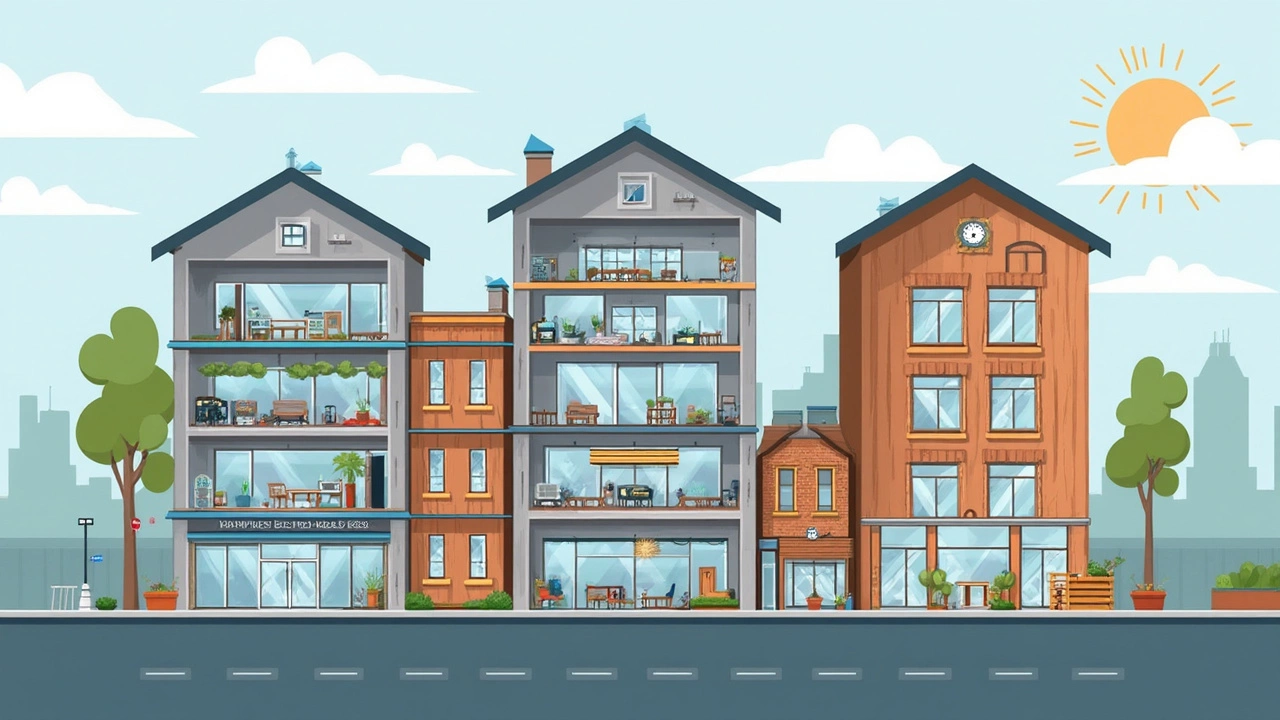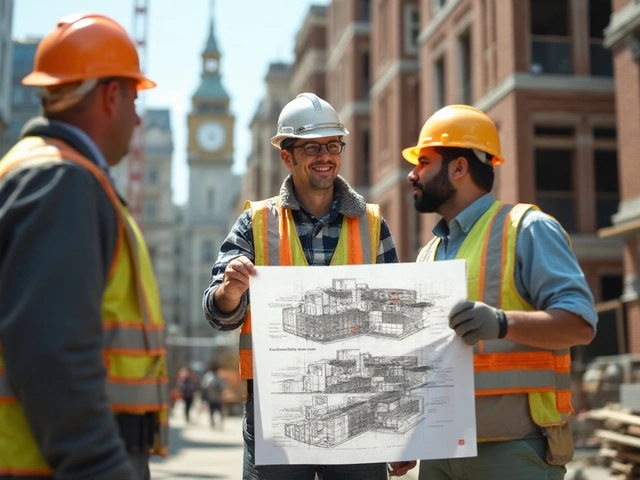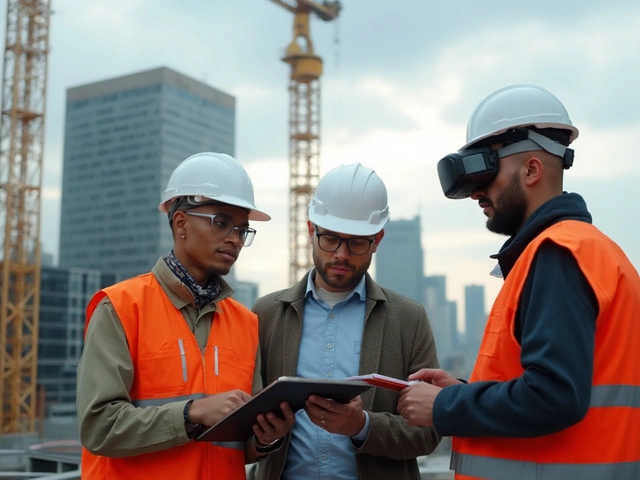Ever wondered why some commercial buildings look like punch-out boxes, while others have that fortress vibe? It’s not just about style—there’s a serious science behind how these structures go up. Picking the right type of construction isn’t just for bragging rights; it affects cost, insurance, safety, and how much you pay if things go sideways.
Before you get any deeper into leases, renovations, or big plans, it helps to know how commercial buildings are classified. We’re talking about more than just a blob of concrete or steel; these labels decide how a building handles fire, weather, and wear over time. Want to spot the difference between a strip mall and a hospital? Understanding construction types gives you superpowers you didn’t know you needed.
- Why Commercial Construction Types Matter
- Breaking Down Building Classifications
- Fire Ratings: The Real MVP
- Material Choices: Steel, Concrete, and Beyond
- How to Tell What Type You’re Looking At
- Tips for Owners and Tenants
Why Commercial Construction Types Matter
Most folks don’t realize how much hangs on knowing a building’s commercial construction type. If you’re an owner, manager, or even a curious tenant, the type literally impacts your wallet, safety, and business interruptions when bad stuff happens. Start with insurance — rates go up or down depending on the building type because some structures resist fire or storms better than others. Run a restaurant, daycare, or medical office? The construction type will set the rules for everything from what kind of renovations you’re allowed to do to how many people you can squeeze inside.
Laws and local building codes care a lot about construction classification. For example, a warehouse made with steel framing isn’t held to the same code requirements as a brick office tower. Cities use these categories to figure out safe occupancy, fire escape plans, and even where these buildings can be placed on the block.
Here’s a quick peek at how construction types shape your everyday operations:
- Fire ratings decide how long your building can stand up to flames before collapsing. Most offices and shopping centers need higher ratings than your average retail strip.
- Material choices — like steel, concrete, brick, or wood — don’t just change the way the building looks. They affect maintenance needs, resale value, and even how fast you can build or remodel.
- Lenders and insurers ask for your building’s classification before they cut you a deal. Skip this step, and you could miss out on better rates or city approvals.
Believe it or not, about 60% of commercial property owners only find out their building type when something goes wrong — like when they hit snags during renovations or after a surprise inspection. It pays to know up front. Think of construction type as the foundation for every business move inside those walls. That’s not just builder talk; it’s real world dollars, safety, and peace of mind.
Breaking Down Building Classifications
If you've ever looked at a commercial building and wondered, 'What kind is that, exactly?'—you're not alone. Commercial construction breaks down into five main types. These are set by the International Building Code (IBC), which nearly every city sticks with. The point? It tells you how fire-safe a building is, what it’s made out of, and sometimes even how long it'll last if things go wrong.
- Type I (Fire Resistive): Think skyscrapers and big hospitals. These are built out of reinforced concrete and protected steel, made to handle serious fires. Sprinklers and thick walls rule here.
- Type II (Non-Combustible): Warehouses and shopping centers often use this. Still safe, but materials might not hold up quite as long as Type I in a fire. Everything from metal roof decks to concrete block walls is fair game.
- Type III (Ordinary): You’ll find tons of small office buildings and schools using this setup. The exterior walls are non-combustible (like brick), but everything inside—wood framing, floor joists, roof trusses—could burn.
- Type IV (Heavy Timber): This is the "mill construction" old factories love. Massive wooden beams you can hug; they don’t burn super fast, so that buys time in a fire.
- Type V (Wood Frame): Strip malls and two-story office buildings fit here. Nearly the whole thing is wood, so it’s fast and cheap to go up, but doesn’t handle fire well.
"Choosing the correct building classification is key not just for safety but for long-term costs and compliance. One oversight can increase insurance 30% or more," says the National Fire Protection Association.
Here’s a quick cheat sheet, straight from commercial construction code nerds:
| Type | Main Materials | Typical Use | Fire Resistance |
|---|---|---|---|
| I | Concrete, Protected Steel | Hospitals, High-rises | 3-4+ hours |
| II | Concrete, Steel | Big Box Retail, Warehouses | 1-2 hours |
| III | Brick, Wood Frame | Schools, Small Offices | 0-2 hours |
| IV | Heavy Timber | Historic Mills, Lofts | 1-2 hours |
| V | Wood Frame | Small Retail, Apartments | 0-1 hour |
Understanding these building types goes beyond trivia—it affects everything from your construction budget to what kind of tenants you can attract. When in doubt, ask your building official or engineer. They live for this stuff (and you don’t want to mess it up).
Fire Ratings: The Real MVP
If you ever wondered why your insurance guy asks about your building’s fire rating, it’s not just paperwork—fire ratings can make or break a commercial construction project. Basically, a fire rating tells you how well a building stands up when things get hot, literally. Every wall, floor, or ceiling usually has a label: how many hours it can keep flames from busting through. That matters a lot more than you might think—both when lives are on the line and when you’re calculating repair costs.
Most building types are split into five main categories (Type I through V, if you want to sound smart), and each comes with its own fire resistance expectations. Type I buildings, like big city hospitals and skyscrapers, are designed to last up to 2–3 hours during a fire because they’re mostly made of concrete and protected steel. Lower-rated types, like typical strip malls (Type III or V), might only hold up for about an hour—or less—because there’s more wood or lighter materials involved.
| Construction Type | Common Materials | Minimum Fire Resistance |
|---|---|---|
| Type I | Reinforced Concrete, Protected Steel | 2-3 hours |
| Type II | Unprotected Steel, Concrete Block | 1-2 hours |
| Type III | Block or Brick with Wood Floors | 0-2 hours |
| Type IV | Heavy Timber | 1 hour |
| Type V | Wood Framing | 0-1 hour |
Fire ratings aren’t just something inspectors care about—these numbers affect your building safety and can change what you pay for insurance (and whether you qualify at all). If you run a restaurant with a big, open kitchen, or if you store sensitive stuff, those extra minutes in a fire can be a lifesaver. And cities often have tough rules: a high-rise in downtown Atlanta might need a higher fire rating than your neighborhood coffee shop in the suburbs.
- Tip: Always check your local building codes before renovations. Upgrading a wall or ceiling can sometimes bump up your fire rating and save seriously on costs (and stress) down the line.
- If you lease space, ask for documentation on fire-rated assemblies. Don’t just take someone’s word for it.
Bottom line? Fire ratings are the unseen side of commercial construction that keep both people and your bottom line safer. Knowing the numbers makes you way more informed, whether you’re building, buying, or just paying rent.

Material Choices: Steel, Concrete, and Beyond
When folks talk about commercial construction, the first thing that pops up is what the building is made of. The main players are steel and concrete, and each comes with its own perks and problems. Ever walked onto a jobsite and seen those massive skeletons of steel beams? That’s not just for show. Steel structures go up fast, can handle taller designs, and give you those wide-open spaces you see in most warehouses and big-box stores.
Concrete, on the other hand, screams durability. You find it everywhere from old-school banks to new hospitals. Why? It’s sturdy, it doesn’t burn, and it stands up to rough weather. If you want a building that doesn’t flinch in a storm or fire, concrete is your go-to.
"Steel and concrete remain the backbone of commercial buildings because of their proven strength, safety profile, and adaptability," says the National Institute of Building Sciences.
There are some facts worth knowing before choosing a material:
- Steel lets you build higher and faster but costs more upfront.
- Concrete makes sense for tight budgets and high safety requirements.
- Combo structures (mixing steel frames and concrete floors) are getting more popular for balance and flexibility.
Here’s a quick look at how these materials stack up in real life:
| Material | Fire Resistance | Build Time | Average Lifespan |
|---|---|---|---|
| Steel | Needs fireproofing | Shorter | 50-100 years |
| Concrete | Excellent | Longer | 75-100+ years |
Don’t forget about wood and modern stuff like cross-laminated timber and composites, but they play a much bigger role in smaller, low-rise buildings. If you need to meet strict insurance or code rules, concrete and steel still run the game in commercial construction.
The bottom line? Don’t shrug off the material used in your building—it controls everything from cost to how you remodel later. If your business relies on open layouts, check for steel. If you’re worried about fire codes, concrete is your friend. Smart owners dig into this early to dodge headaches down the road.
How to Tell What Type You’re Looking At
Here’s where things get practical. You don’t need a hard hat or degree in commercial construction to figure out a building’s type. All it takes is knowing what to look for—and sometimes, who to ask.
The main construction types boil down to fire resistance and materials. They’re usually labeled in five categories (Type I through V), but most people spot the differences by noticing what holds the place together and how it’s finished.
- Steel and Concrete Everywhere: If you walk into a high-rise office or hospital with exposed concrete columns and steel beams, you’re probably in a Type I building—think super fire-resistant, made for big crowds or critical operations.
- Brick or Block Walls, Wood Roof: That old school or suburban strip mall? If you see load-bearing masonry (like bricks or cinder block), but the roof looks like standard lumber, it’s often Type II or III.
- Wood Frame Galore: If you can see wood framing, especially in spaces that feel like giant houses (such as retail chains or small medical offices), it’s likely Type V—these go up fast and keep costs down, but aren’t as tough against fire.
You can also:
- Peek at the ceiling tiles or vents. Spray-on fireproofing (looks woolly/gray) hints at steel frames.
- Check the exits. Big, fire-rated doors and stairwells wrapped in concrete? That's a sign of serious fire protection—usually Type I or II.
- Look at the age and height of the building. Anything taller than six stories is almost always steel and concrete by code.
- If you’re still unsure, ask for the building’s construction classification—the info is usually in property management files or fire inspection reports.
Here’s a handy cheat sheet for quick reference:
| Type | Main Materials | Common Examples | Fire Resistance |
|---|---|---|---|
| Type I | Steel & Concrete | Hospitals, High-Rises | Highest |
| Type II | Steel/Concrete (less protection) | Warehouses, Industrial | High |
| Type III | Masonry Exterior, Wood Interior | Schools, Malls | Moderate |
| Type IV | Heavy Timber | Old Factories, Breweries | Moderate |
| Type V | Wood Frame | Small Shops, Offices | Lowest |
Knowing these signs isn’t just trivia—it can save you money on insurance or give you peace of mind when leasing space in a new spot. Next time you walk into a building, take a second to look around. The clues are right in front of you.
Tips for Owners and Tenants
If you own or rent a commercial property, knowing the commercial construction type isn’t just interesting trivia—it could save you a ton of money and headaches. Different building types react differently in emergencies and routine usage. Insurers and city officials pay close attention; so should you.
- Ask for Documentation: Get the blueprints or ask the building manager for the official classification. It’s usually labeled as Type I through V construction. This matters—Type I (fire-resistive) is often concrete and steel, great for tall buildings, while Type V (wood frame) is your budget-friendly strip mall or restaurant shell.
- Stay on Top of Fire Ratings: Buildings with higher fire ratings (Types I and II, for example) can lower your insurance premiums. Some insurance companies offer up to 20% lower rates for offices in high-rated construction classifications.
- Plan Upgrades with Material Limits in Mind: Not every wall can be knocked down or changed. Type III and IV buildings (think heavy timber or brick) don’t like big surprises—major structural changes get complicated (and pricey fast).
- Look Into Local Codes for Renovations: Codes can get picky. A 2023 study in Texas found about 60% of rejected permits for commercial remodels were due to confusion over existing construction types and code compliance. Checking before you start beats having to redo stuff later.
- Pay Attention to Regular Maintenance: Older buildings, especially Type V wood frames, are more vulnerable to water damage, pests, and fires. Stay on top of roof leaks, electrical checkups, and pest control to avoid nasty surprises.
If you’re a tenant, don’t be afraid to ask questions before signing. Does the landlord keep up with fire inspections? What material is behind those "nice" finished walls? Knowing your building’s construction classification—and what it means for HVAC, safety, and rent hikes—puts you in a better spot to negotiate and plan for the future.
| Type | Material Example | Fire Rating (hours) |
|---|---|---|
| I (Fire Resistive) | Concrete & steel | 2-3 |
| II (Non-combustible) | Metal walls/roof | 1-2 |
| III (Ordinary) | Brick & wood | 0-2 |
| IV (Heavy Timber) | Thick wood beams | 1-2 |
| V (Wood Frame) | Wood studs & joists | 0-1 |
Bottom line: keep records, ask questions, and don’t assume all commercial buildings are the same. A little digging now helps you avoid trouble down the road.





